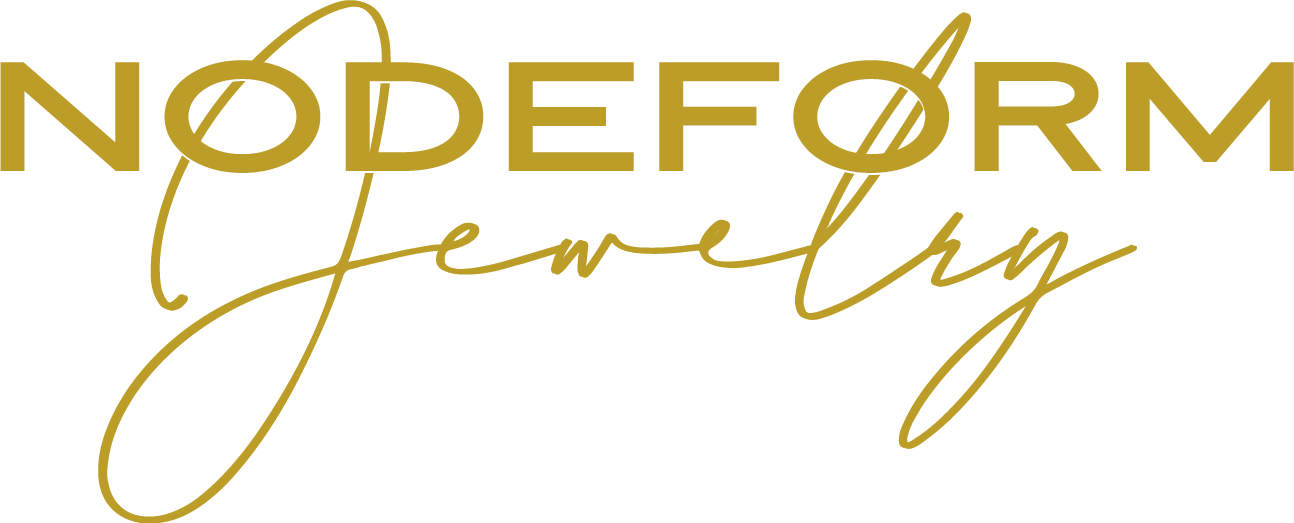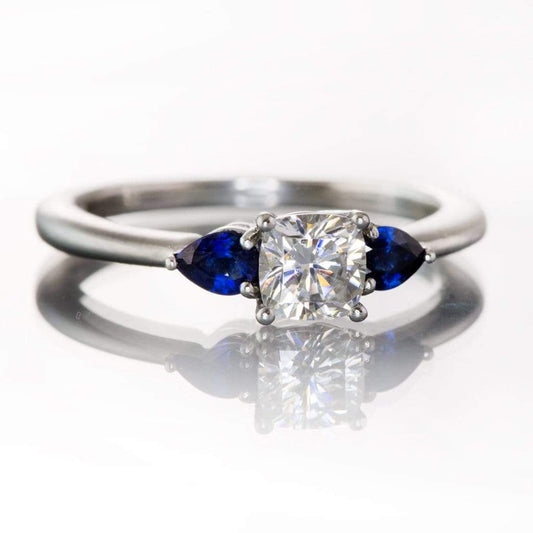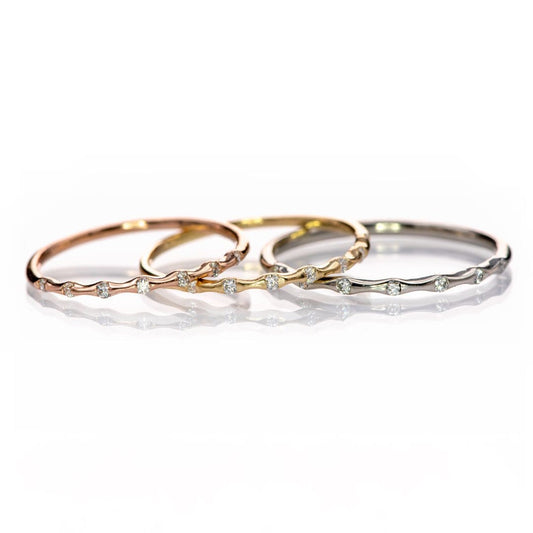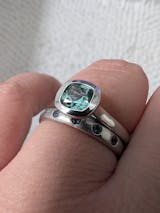This is a description on how I can get from a idea in my head to having castable wax models in my hand by using new prototyping technology as opposed to carving directly in wax by hand. I still carve about 90% of all my design by hand. But some designs are just easier and more effective to do using CAD tools. It still takes considerable time to model and then prototype. It's definitely not as quick as some might think. It does not make sense to use it for one off designs but it's a great tool for designs using repetitive elements. It allows me to do more precise and detailed work than what I can do by hand carving. Eternity bands with repetitive settings around the entire ring are a great example for using CAD.
Real eternity bands are so tough to size with the pattern or settings needing to be equally distributed around the entire ring. It always ends up being a huge mess when people did not give me the correct size upfront and then need it resized. I usually end up making a totally new ring. This happened twice in the last 2 weeks with an order for one of my
Wave rings. Now I am on the 3rd ring to make for that customer. Well, I am really learning how to make this ring in various sizes. :) The half eternity design one should solve that issue as the lower shank part can easily be cut and resized. Plus it also makes the stone setting go faster. Makes a huge difference in time and ultimately cost if there are 4, 8 or 16 stones to set in a ring. For this one I wanted to use 2mm round faceted stones for simplicity. So that is what I have in mind:
 |
| Rendering of ring design. |
Let's start:
I modeled one rounded, kind of blobby looking, setting at the top. Lot's of pushing and pulling to create the shape. This works similar to clay modeling just in the digital world. That's why I love
T-splines modelling software so much. It allows me to work with those digital tools pretty similar to
how I carve my wax models by hand just using the mouse pointer and not carving tools.
 |
| round bubbly stone setting |
After I had the main setting I used what works so great in CAD: the ability to copy things. I can use a radial symmetry function that allows me to array multiple settings around the center. With that only one setting get's modified until I am happy with it. All the copies, that were arrayed, get updated with those changes automatically. It's a huge time saver and I can do lots of modifications on the fly. I LOVE the symmetry function in T-Splines! The green lines in the model represent where the symmetry axises are. If all is to my liking, the copied settings just need to get bridged together to make one uniform connected model.
 |
| Array of 4 bridged round setting |
A lower shank was modeled and connected to the last setting on each side.A bit more pushing and pulling to get the final shape perfected.
I also thought to try adding a matching stacked band next to it. So I extracted the isocurve of one side of the ring and used it to create the band that would snuggle perfectly next to the stone set ring. The curve was extruded to create the ring width. The "TSthicken" function then created a volume out of the flat surface.
 |
| Creating the matching stacked band. |
Lot's of "digital clay" pushing and pulling to give the band the final shape.
 |
| Final ring set. |
Quick renedering to check the design.
 |
| Rendering of the rings without stones. |
The models then get converted from T-Spline models into to Rhino Nurbs.
 |
| T-splines models converted into Rhino-nurbs. |
This then gets converted into a mesh and exported into a STL file that can be read by a 3D printer or CNC milling software. The big advantage of working with T-splines is that the models are always watertight, fully closed without any open edges. When I previously was only working with Rhino and tried to create similar blended surfaces, I often encountered that the final models had tiny openings from blending operations. It made it impossible to print or mill them as the prototyping only works with completely "watertight" models. Since using T-Splines I never encounter that frustrating problem again and creating smooth blended transitions is so much easier now.
 |
| Mesh, ready for export. |
|
Previously I would now send this STL file to a 3D printing service to either get a high resolution (and expensive around 80-100$ per ring) resin/wax model printed in 3 days or send it to Shapeways for a lower resolution print in their
Ultra-detail plastic that cost around 6$ per ring. It takes a bit longer (about 2 weeks) and the prints have a bit of texture (which looks sometimes really nice if I am going for that textured look). The models can be cast directly but the burnout is not always totally clean. One can also make a silicone mold of the printed model and than create wax copies. The wait time and/or higher price for the high resolution models usually put a big stop on my creative flow when I wanted to come up with new designs.
Beginning of May I got a used CNC mill from
Otto Frei. It's a Roland JWX-10 4th axis CNC mill that came with
Protowizard software and ring fixtures. The customer service at Otto Frei was great. They serviced the machine, calibrated all the fixtures and even provided support over the phone to get it setup and started. It's an expensive tool, even used, but so much fun. It opens up lots of new possibilities. Now I can go from idea to having wax models in my hand in the same day in just a couple hours and start casting afterwards immediately. It allows me to really try of lot's of options and evaluate them quicker. It will take a while to recoup the cost but I think it's worthwhile.
So with that new tool I transfer the STL file from my MAC book pro where I model (in Rhino4 for Windows via Parallels) to my old PC that is connected to the CNC mill.
 |
| Programmed milling path with supports and CNC mill on right. |
There in the protowizard software I program the milling operations, set tools, supports and milling path. For this ring I chose to use the Tube Wizard as it allows me to mill both rings at the same time. It will only mill the outer surface of the ring, not the sides. But the detail on the sides it easy to do by hand after it's milled as it only required some rounding with some wax files and smoothing with sand paper. Milling never does undercuts like hollowing out the underside of a setting. Those things have to be done by hand carving the wax. Since I am used to carving it's not a problem for me. The milling waxes are the same as the carving waxes. They can easily get modified after milling to do adjustments needed for proper stone fit, hollow out and casting preparation. Models with lot's of undercuts are better to be done by 3D printing. But those machines are a lot more expensive and the models are not as easy adjustable after they were printed.
The programmed path get then loaded into the mill software. The mill gets prepared by inserting the right milling tool bit, a wax rod is mounted on the rotary fixture and the zero point set to make sure the tool does only mill wax and does not accidentally run into the metal fixtures. Then it starts milling. Here a video of the mill in operation :
A single milling in fine mode for these 2 rings takes about 50 minutes to complete.
More more complicated models that first get milled on each side with a flip fixture and then on the rotary axis this whole process can easily take 2 hours and requires tool changes in between.
 |
| Finished milled rings still attached to the wax rod via rectangle supports. |
So from this point on all further work is done by hand just like I do all my other rings from the tool mark removal, to casting prep, metal casting itself and then all the clean-up work after the casting, polishing, stone setting etc. For this milled part the wax shavings need to get cleaned out and the rings cut off from the supports. The sides get filed to remove the support stubs. Then I size the inside with a wax reamer and adjusted any other things like smoothing the inside, hollowing out etc.
 |
| Finished wax models ready for casting prep. |
I like it and went back to model software to play with a few design modifications like making the settings into a half bezel by cutting out a path. I also played with different width for the matching wedding band and created a set for slightly larger stones by scaling the settings. It's fairly easy to go back to the model in T-splines and make changes, then reconnect the parts and do the steps for the model export again and bring it into the milling software.
 |
| Stacked rings. |
 |
| Variations of the same design by altering the settings in the CAD software and playing with different ring width. |
So at the end of the day I had 3 rings sets that could be cast in the next few days.


































